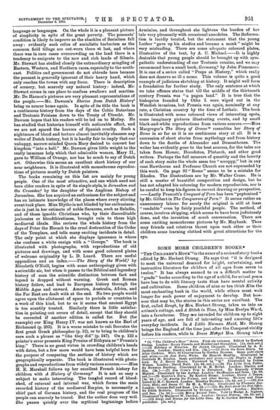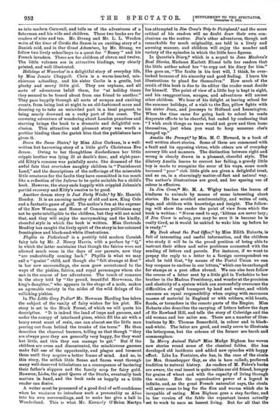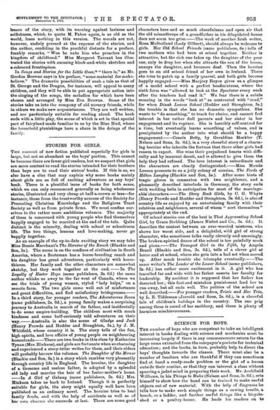SOME MORE CHILDREN'S BOOKS.*
"THE CHILDREN'S HOUR" 1S the name of a series of story-hooks edited by Mr. Herbert Strang. He says that "it is designed to meet the universal demand for bight, entertaining, and instructive literature for children of all ages from seven to twelve." It has always seemed to us a difficult matter to "grade" books according to the age of a child, for actual years have less to do with literary taste than have mental activity and cultivation. Some children of nine or ten think Kim the most enchanting hook in the world, while others must wait longer for such power of enjoyment to develop. But how- ever that may be, the stories in this series are excellent. The first, called Rough, by Mrs. Herbert Strang, takes us into an artisan's cottage, and A Stitch in Time, by Miss Evelyn Ward, into a farmhouse. They are intended for children up to eight years of age, and are full of interesting and amusing litCe everyday incidents. In A Little Norman Maid, Mr. Strang brings the England of the time just after the Conquest vividly before his readers, while in Brave Matget Mrs. Strang takes • (1) "The Children's Hoar" Series. First six volumes. Edited by Herbert Strang. London: Henry Frowde and Hodder and Stoughton. [Is. each net.] —(2) Holidays at Waverlea. By Jennie Chappell. Illustrated by A. F.. Jackson. London : Mackie sad Son. [28.1—(d) Down the Snow Stairs. By Alice Corkran. With 60 Illustrations by Gordon Browne. Same pubtehers and price.—(4) Just Forty Wiuks. By Hamish Hendry. Illustrated by Gertrude hr. Bradley. Same publishers and price.—(5) Phyllis in Piskie- Land. By J. Henry Harris. Foreword by "Q." Illustrated by Patten Wilson. London : David Nutt. [3s. 6d. net.]—(6) The Little Grey Pedlar. By Newman Harding. Illustrated by H. R. Millar. London : Mackie and Son. [2s.]—(7) Jim Crou's nip to Fairyland. By Kennedy O'Brien Martyn. Illustrated by the Author. London Skeffington and Sons. [Ss. 6d. net.]—(8) Quentin's Diary. By Karlott 'Bosse. London: Henry J. Deane. [3s. 6d.] — (9) Amelia the Prompt, and other Stories. WI Mon and Illus- trated by M. CA:toward. London : Headley Brothers. [2s. 6d. net.]—(10) Jins Crow, Blobs, and Sweep 0! By M. A. Wigley. Illustrated by Florence Jay. London: George Bell and Sons. [Is. 6d.]—(11) My Boo's about the Post Office. By Edith Robarts. Illustrated by Thomas Sweet-Sold. London : Blackic. and Son. [Is. 6c1.]—(121 Merry Animal Tales. Told by Madge A. ltigbain. Illustrated by Margaret W. Tarrant. London: George Harrap. (2s. 6d. net.] —(13) Songs and Stories for the Little Ones. By E. Gordon Browne. Same publisher. [2s. netd
as into modern Cornwall, and tells us of the adventures of a fisherman and his wife and children. These two books are for readers of nine and ten. Mr. Strang and Mr. L. L. Weedon write of the time of Cerdic the Saxon in an exciting story of a Danish raid, and in Our Great Adventure, by Mr. Strang, we follow two lively schoolboys in a quest for " Honey " and his French invaders. These are for children of eleven and twelve. The little volumes are in attractive bindings, very clearly printed, and well illustrated.
Holidays at Waverlea9 is a delightful story of everyday life, by Miss Jennie Chappell. Chris is a warm-hearted, mis- chievous schoolboy, and his sister Carlie is a gentle, but plucky and merry little girl. They are orphans, and all sorts of adventures befall them, for "at holiday times they seemed to be tossed about from one friend to another." They pass happily through all sorts of scrapes and exciting events, from being lost at night in an old-fashioned maze and dressing up to take an uninvited part in a local pageant, to being nearly drowned on a rocky part of the coast. The crowning adventure of wandering about London penniless and starving brings the book to a dramatic and delightful con- clusion. This attractive and pleasant story was worth a prettier binding than the garish blue that the publishers have given it.
Down the Snow Stairs,3 by Miss Alice Corkran, is a well- written but harrowing story of a little girl's Christmas Eve dream. Owing to her thoughtless disobedience her little cripple brother was lying ill at death's door, and eight-year- old Kitty's remorse was painfully acute. She dreamed of the awful fate that overtakes naughty children in "Punishment Land," and the descriptions of the sufferings of the miserable little creatures for the faults they have committed is too much like a reflection of the Inferno to be quite suitable for a child's book. However, the story ends happily with crippled Johnnie's partial recovery and Kitty's resolve to be good.
Another dream story is Just Forty Winks,' by Mr. Harnish Hendry. It is an amusing medley of old and new, King Cole and a fantastic game of golf. The author's fun at the expense of the New Woman and House of Commons politicians may not be quite intelligible to the children, but they will not mind that, and they will enjoy the merrymaking and the kindly, cheerful style in which the book is written. Miss Gertrude Bradley has caught the lively spirit of the story in her coloured frontispiece and black-and-white illustrations.
Phyllis in Piskielands is a prettily told modern Cornish fairy tale by Mr. J. Henry Harris, with a preface by "Q," in which the latter maintains that though the fairies were not allowed much room in the days of our parents, now they "are undoubtedly coming back." Phyllis is what we may call a " quaint " child, and though she "felt strange at first" in her new surroundings, she soon grew accustomed to the ways of the piskies, fairies, and royal personages whom she met in the course of her adventures. The touch of romance in the story told by "the proud, beautiful Morwenna, the king's daughter," who appears in the shape of a mole, makes an agreeable variety in the midst of the wild doings of the rollicking pis'kies.
In The Little Grey Pedlar's Mr. Newman Harding has taken the subject of the vanity of fairy wishes for his plot. His story is set in the Black Forest, of which we will quote his description. "It is indeed the land of imps and gnomes, and under the canopy of interlaced pines, which fill the air with a heavy sweet scent of resin, one can almost see the little men peering out from behind the trunks of the trees." He then describes the charcoal burners, telling us that though "they are always poor they are generally very happy, for they want but little, and this they can manage to get." But if the children are cross and discontented, the mischievous gnomes make full use of the opportunity, and plague and torment them until they acquire a better frame of mind. And so, in this story, the selfish little Sonso and Sanaa went through many well-deserved tribulations as a consequence of bartering their father's slippers and the family soup for fairy gold. However, Liebe., the good Queen of the Storks, eventually took matters in hand, and the book ends as happily as a little reader can desire.
A writer must be possessed of a good deal of self-confidence when he ventures to introduce such a personality as Alice into his own surroundings, and to make her give a ball in Wonderland. This is what Mr. Kennedy O'Brien Martyu has attempted in Tim Crow's Trip to Fairyland,7 and the more critical of his readers will no doubt draw their own con- clusions on the matter. Jim's other adventures, though not remarkable for much originality, are told in a lively and amusing manner, and children will enjoy the number and variety of the episodes in which the little hero figures.
In Quentin's Diary,9 which is a sequel to Joan Maclean's Real Stories, Madame Karlott Elosse tells her readers that the little author asked her "to copy out his diary for him." She goes on, "The faults in his text will, I think, be over- looked because of his sincerity and good feeling. I leave his illustrations to plead for themselves." How much of the credit of this book is due to its editor the reader must decide' for himself. The point of view of a little boy is kept in sight, and his exaggerations, scrapes, and adventures will amuse other children. We hear of his delight at leaving school for the summer holidays, of a visit to the Zoo, pillow fights with his sister Joan, and journeys to Holland and Leamington. When the time came for going back to school he made desperate efforts to be cheerful, but ended by confessing that "I wish such things as tears would not grow and then loose themselves, just when you want to keep someone else's bunged up."
Amelia the Prompt,9 by Mrs. M. C Howard, is a book of well written short stories. Some of them are concerned with a fault and its opposing virtue, while others are of everyday nursery life and manners. The distinction between right and wrong is clearly drawn in a pleasant, cheerful style. The dilatory Amelia learns to correct her failing, a greedy little boy is made to recognize the error of his ways, some much harassed "poor" rich little girls are given a delightful treat, and so on, in a charmingly matter-of-fact and natural way. The author's illustrations are good, and her sparing use of colour is effective.
In Jim Crow," Mr. M. A. Wigley teaches the lesson of kindness to animals by means of some interesting short stories. He has avoided sentimentality, and writes of cats, dogs, and children with knowledge and insight. The follow- ing will show the reader the point of view from which the book is written: "Nurse used to say, 'kittens are never lazy; if Jim Crow is asleep, you may be sure it is because be is really tired, so it would be unkind to wake him up before he is ready.'" My Book about the Post Office," by Miss Edith Robarts, is full of interesting and useful information, and the children who study it will be in the proud position of being able to instruct their elders and solve problems connected with the sending of letters and parcels. For instance, if we want to prepay the reply to a letter to a foreign correspondent we shall be told that, "by means of the Postal Union we can buy coupons to enclose in our letters," which can be exchanged for stamps at a post office abroad. We can also here follow the course of a letter sent by a little girl in Yorkshire to her brother in the Madras Presidency, and wonder at the precision and elasticity of a system which can successfully overcome the difficulties of rapid transport by land and water, and which assumes an equal responsibility when coping with enormous masses of material in England or with robbers, wild beasts, floods, or tornadoes in the remote parts of the Empire. Miss Roberts also describes the carrying of letters before the days of Sir Rowland Hill, and tells the story of Coleridge and the old woman and her sailor son. There are a number of illus- trations by Mr. Thomas Somerfield, in colour and in black- and-white. The latter are good, and really serve to illustrate the letterpress, but the colours of the former are harsh and commonplace.
In Merry Animal Tales" Miss Madge Bigham has woven new stories round some of the classical fables. She has developed old incidents and added new episodes with happy effect. Like La Fontaine, she has, in the case of the cicala (or Mrs. Grasshopper Gay, as she is here called), preferred tradition to natural history. As readers of M. Fabre's books are aware, the real insect is quite unlike our old friend, hungry for grains of wheat and with the capacity of living through the winter. But the reproductive power of a legend is infinite, and, as the great French naturalist says, the cicala. will never cease to beg for the flies and worms which she is incapable of eating. Miss Bigham goes a step further, and in her version of the fable the repentant insect actually set to work to earn an honest living. But for all that the lesson of the story, with its warning against laziness and selfishness, which, to quote M. Fabre again, is as old as the world, loses nothing in this version. The morals are not, however, unduly pressed at the expense of the stories, and the author, confiding in the youthful distaste for a preface, frankly remarks, "Woe be unto him who preaches in the kingdom of childhood." Miss Margaret Tarrant has illus- trated the stories with amusing black-and-white sketches and a coloured frontispiece.
In Songs and Stories for the Little Ones,o "there is," 28 Mr. Gordon Browne says in his preface, "some material for make- believe." The dramatic possibilities of such a tale as that of St. George and the Dragon, for instance, will appeal to many children, and they will be able to put appropriate action into the singing of the songs, the melodies for which have been chosen and arranged by Miss Eva Browne. Some of the stories take us into the company of old nursery friends, while in others we make new acquaintances. They arc well written, and are particularly suitable for reading aloud. The book ends with a little play, the scene of which is set in that special part of fairyland made familiar to us by the Blue Bird, where the household plenishings have a share in the doings of the fain ily.




































































 Previous page
Previous page